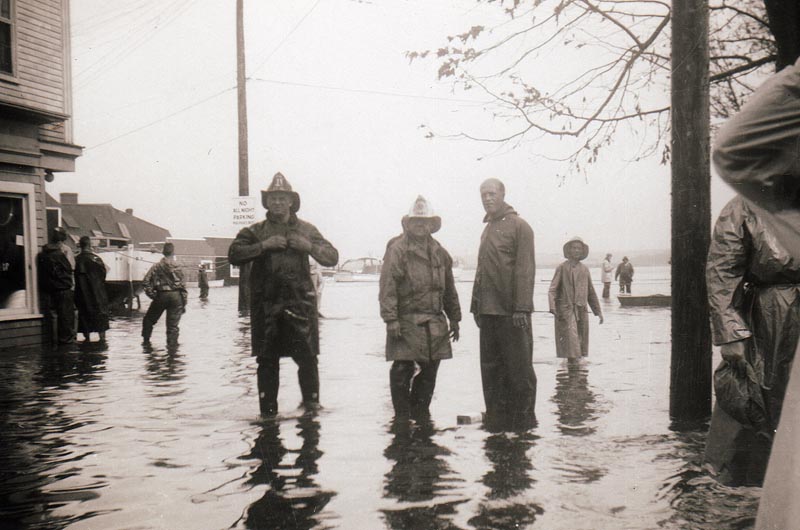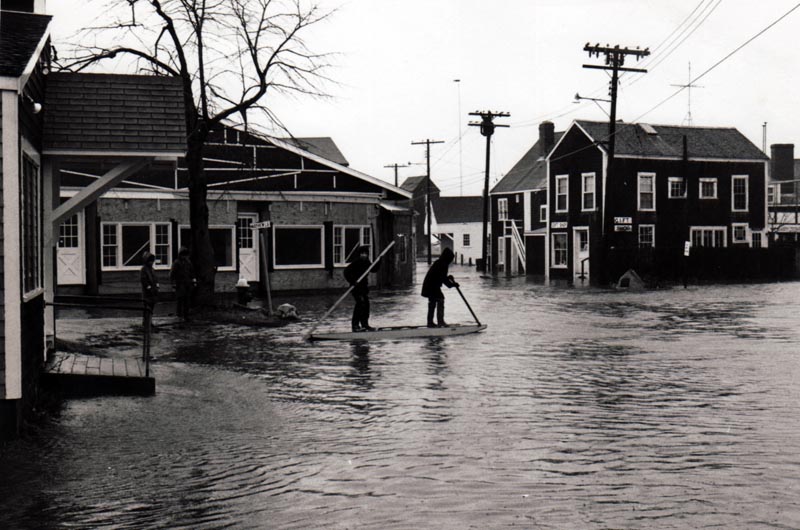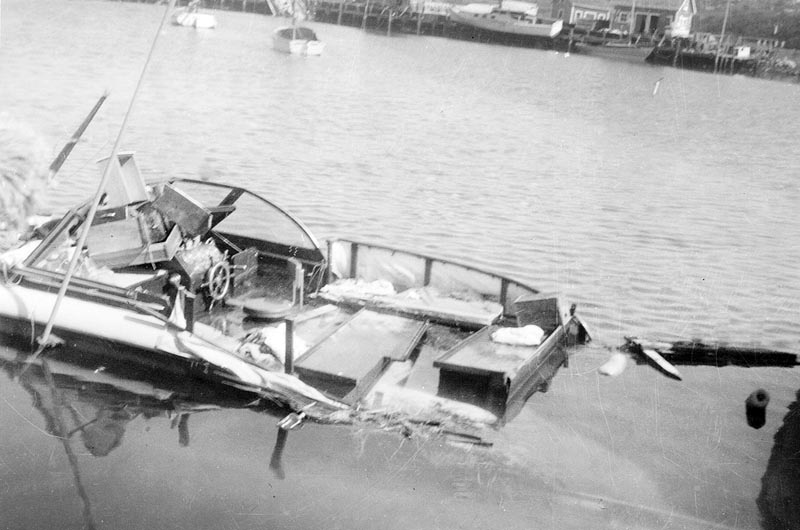Until you know what you’re seeing, it doesn’t look that remarkable.
For 51 seconds, the camera pans a bit jerkily across the sky above a blustery Caleb’s Pond on Chappaquiddick. The film catches a streak of blue overhead, oblong and surrounded by tattered clouds, the colors ranging from pale yellow to purple to menacing black. Under the clouds, the photographer finds the bands of a rainbow, and on his fourth attempt manages to trace them from end to end, arcing vastly over the outer harbor of Edgartown.
It could be a lull in a northeaster, maybe late spring or early autumn. But then Edith W. Potter, who was with her brother in law Sam Potter as he shot the film with an eight-millimeter camera sixty years ago this week, explains what’s on screen. This is the only movie known to show the eye of a hurricane passing directly over the Vineyard and Chappaquiddick.
The hurricane was named Edna, the date was Sept. 11, 1954. The front-page story in the Gazette opened with a sentence that was punchy with drama and exasperation: “It happened again to the Vineyard.”
The note of disbelief was real. Less than two weeks before, Hurricane Carol had ravaged the harbors and shorelines and sections of several towns on the Vineyard, shattering the last full week of the summer season. Eleven days later Edna rammed the destructive point home, striking the Island more directly than Carol and splintering what was left of the splinters 60 years ago this week.
As part of its Historic Movies of Martha’s Vineyard project, the Gazette presents footage of the eye of Edna as it reeled out to sea over Chappaquiddick in the middle of September 1954. The storm center was so large and Edna bisected Martha’s Vineyard so precisely, that the eye was seen and felt in all its strange and sudden stillness from the western to the eastern end of the Island.
At Menemsha, the surge from Carol a fortnight before had pulled Everett Poole’s fish market into the harbor basin, leaving only the roof and a wall behind. Mr. Poole had missed that tempest because he was in the Coast Guard. But he had returned home and was at Menemsha when the sister storm struck.
“I was here for Edna, which actually blew harder than Carol,” he recalled in an interview. “But everything was already wrecked, so it didn’t do a hell of a lot of damage. They had taken the boats that hadn’t sunk here in the harbor [during Carol] up into the pond for Edna. In Edna, the eye went right over here. It went dead calm. I was changing a flat tire, right under a telephone pole by Clifton Parker’s driveway.”
Mr. Poole said the pole had swung enough in the wind to catch his attention; it stopped just long enough during the passage of the eye for him to finish the job and drive away safely.
In Edgartown, Diana (Dinny) Muldaur Dozier, who was 16, sprang outdoors with family and young friends when the quiet came, at about 2:30 in the afternoon.
“All of a sudden the wind stopped dead,” she said. “And we all ran out of the house. There wasn’t a bird singing. There wasn’t a breath of air. There was nothing, no wind, no sound, no water, no rain, anything. Just total silence. Yellow, yellow sky. And then, whack! You got hit again [by the other side of the storm]. Absolutely fascinating!”
Over Caleb’s Pond on Chappy, as filmmaker Sam Potter wrote for the Gazette a few days later: “. . . the sun shone and a great sweep of blue sky appeared. The eye’s rim was for the most part edged with the dark rags of the scud, but here and there we could see the white and crisply detailed clouds of the storm proper. The sound of aircraft broke into the stillness, and a big four-motored plane — the weather bureau’s eye, no doubt — circled along the edge of the blue sky. About us, it looked for all the world like a balmy summer day, and only the grayness and the mist to the north gave notice that this was only a respite, not relief.”
With the eye rotating northeastward toward Nantucket Sound, Edo Potter and her brother in law boarded his truck and drove toward Wasque Point, the southeast elbow of Chappaquiddick.
“The eye was moving fast; though we had a head start, Ford trucks were not designed for puddle-jumping and it was heading out to sea when we arrived,” Mr. Potter wrote. “As we muddled through the chain of small lakes which once had been a Chappaquiddick road, the storm now and then revealed part of its enormous wall — great piles of cloud, as stiff and as formal as a grandfather’s highboy and as substantial as any mountain. Though short, these glimpses made up in awesomeness what they lacked in time.”
During the stillness, the tide in Edgartown harbor “gurgled and moved uneasily in and out like water in a bathtub,” said the Gazette. Curious townspeople left their houses, wandered down to the waterfront with their cameras and “paddled, barelegged, into territory where in the morning mostly boots had trod, taking little heed of what might lurk below.”
In those days, it was unlikely that many of the ramblers understood that the backside of a hurricane could be much more vicious after the center wheels away. At the airport in the middle of the Island, an anemometer measured a gust of 120 miles an hour after the eye passed by — the strongest wind recorded on the Vineyard in modern times. But there is no indication anyone was badly hurt by the dangerous side of the storm.
Sixty years later, Edo Potter recalled the atmospherics at Wasque Point with awe.
“What really intrigued me was that the wind was blowing out to sea and we were standing there watching it, and this cloud came over, and then it got clear. Then all of a sudden, without any kind of introduction, it turned and went the other way. And that really amazed me. Just as the storm came over and the other side hit. I think it was harder, but I don’t think the temperature changed. That was wonderful,” she said.
The landfall of two hurricanes in one year was extraordinary but not unprecedented on the Island. Records at the National Hurricane Center, Woods Hole Oceanographic Institution, Harvard Forest in Petersham and at the Gazette show that strong tropical storms or hurricanes struck the Island twice in 1869 and 1878. Also, the eye of a hurricane, or the center of a powerful tropical storm, crossed directly over the Island or ran up a Vineyard coastline in 1770, 1869, 1879, 1889 and 1896.
After Carol and Edna in 1954, no true hurricane assailed the Vineyard until Bob on August 19, 1991, and no other has struck in the 23 years since. Asked if those living on the Vineyard are ready for what can happen, Dinny Dozier looked back to Carol and Edna.
“Oh, absolutely not,” she said, pointing to those who flock to shorelines during the most threatening storms, or think they can do anything they see on reality television, or put up houses with the idea that a coastline never moves. “No, I think it’s going to be awful. I mean, they wouldn’t be building where they’re building on Martha’s Vineyard if they believed, would they? No, I don’t think there’s any question when you’ve seen it.”
The Historic Movies of Martha’s Vineyard project saves, archives and introduces old Island films to the public. John Wilson, a television director and filmmaker in Edgartown, edited the Hurricane Edna clip from a digital file created by Art Donahue of Motion Picture Transfer in Franklin. For information about the initiative, contact historicmovies@mvgazette.com. (To avoid damage, please do not run an old film through a projector.) To see the collection of 10 Vineyard films presented to date, go to mvgazette.com/historicmoviesofmarthasvineyard.











Comments (7)
Comments
Comment policy »